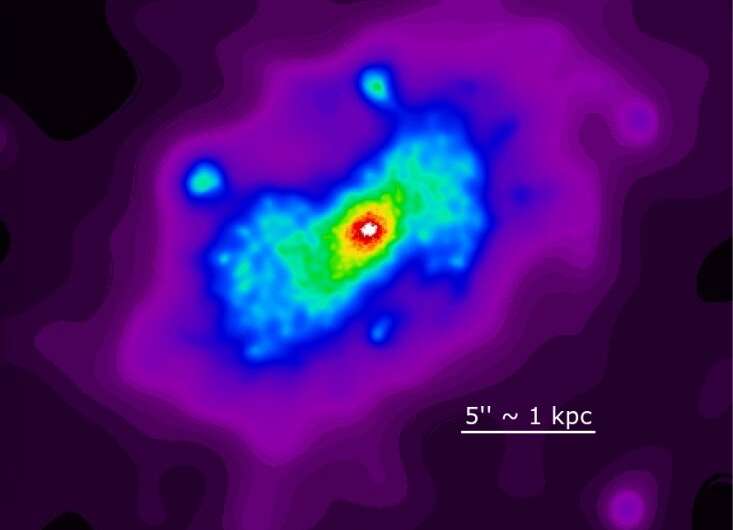NGC 5728: emission in the full-band (0.3–7.0 keV). Credit: Falcao et al, 2023
Using NASA's Chandra X-ray observatory, astronomers have performed deep X-ray observations of a nearby active galaxy known as NGC 5728 and its active galactic nucleus (AGN). Results of the observational campaign, published March 1 on the pre-print server arXiv, deliver important information regarding the properties of this AGN and the emission from it.
AGN are compact regions at the center of a galaxy, more luminous than the surrounding galaxy light. They are very energetic due either to the presence of a black hole or star formation activity at the core of the galaxy.
Located some 146 million light years away in the constellation of Libra, NGC 5728 is an active barred spiral galaxy with a size of nearly 100,000 light years and an estimated mass of about 72 billion solar masses. It is a Seyfert galaxy of type 1.9, with a heavily obscured and complex AGN powered by a supermassive black hole (SMBH) at its center.
A team of astronomers led by Anna Trindade Falcao of the Harvard-Smithsonian Center for Astrophysics (CfA) in Cambridge, Massachusetts, decided to observe NGC 5728 with Chandra's Advanced CCD Imaging Spectrometer (ACIS) with the main aim of determining the detailed morphological and spectral properties of the extended X-ray emission from the galaxy's AGN.
"We analyze the deep Chandra observation of the CT AGN NGC 5728 to study the kpc-scale diffuse X-ray emission, both spectrally and spatially, as a function of energy," the researchers wrote in the paper.
In result, the observations detected a lower energy total extent of about 13,000 light years in the direction of the major axis of NGC 5728, which is also the direction of the ionization bicone. The results suggest an energy-related trend in the size of the extended emission, with the softer emission (below 3 keV) being more extended than the harder emission.
The study found that the diffuse emission is also extended in the cross-cone direction and that the transmission in the cross-cone direction is about 2% of the bicone direction. The data indicate the presence of hard X-rays on kiloparsec scales, suggesting a non-uniform, clumpy torus structure, which allows the radiation to escape from the circumnuclear region to larger radii.
Furthermore, the results show that the ratio of detected photons in the cross-cone to the bicone region is about 16%, below 3 keV, and decreases to approximately 5% for the 3–6 keV energy range. The astronomers assume that a larger concentration of dense molecular clouds in the central region might be the cause of this phenomenon since these clouds are responsible for scattering and reflecting the high-energy photons from the nucleus in the galaxy disk.
By analyzing the data, the researchers concluded that thermal components for NGC 5728 can be explained by interstellar medium interactions, shocks, or supernova remnants/star formation from the nearby star-forming ring.
More information: Anna Trindade Falcao et al, Deep Chandra Observations of NGC 5728: Morphology and Spectral Properties of the Extended X-ray Emission, arXiv (2023). DOI: 10.48550/arxiv.2303.00789
Journal information: arXiv
© 2023 Science X Network
























